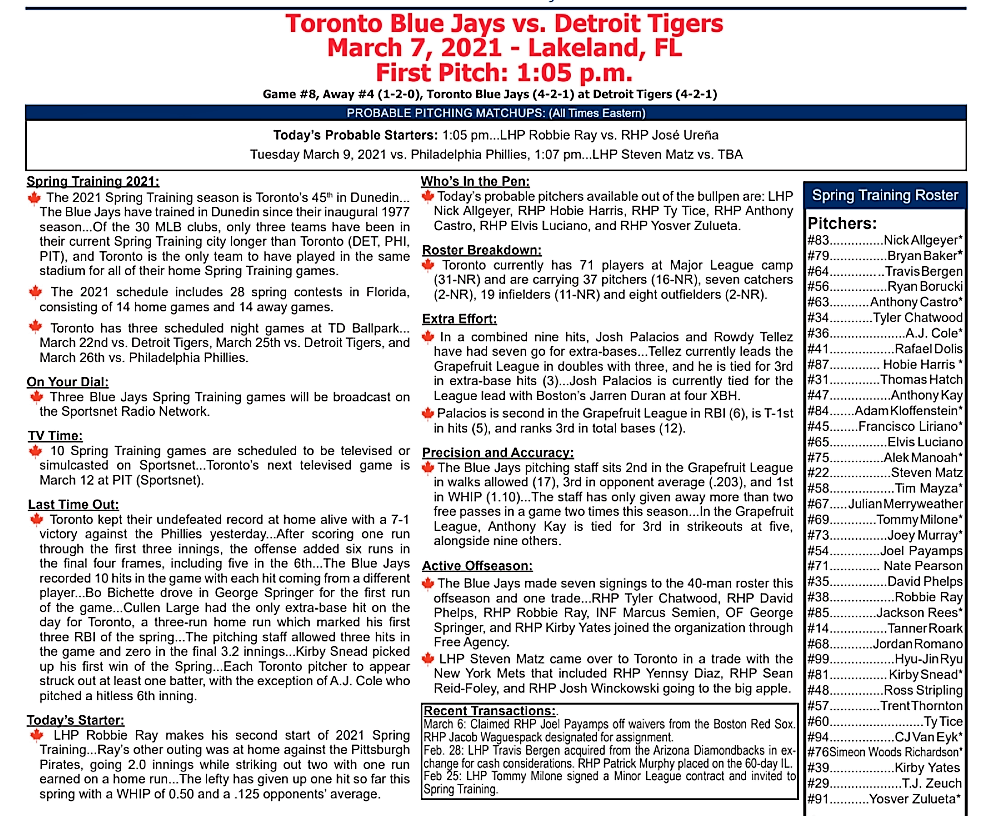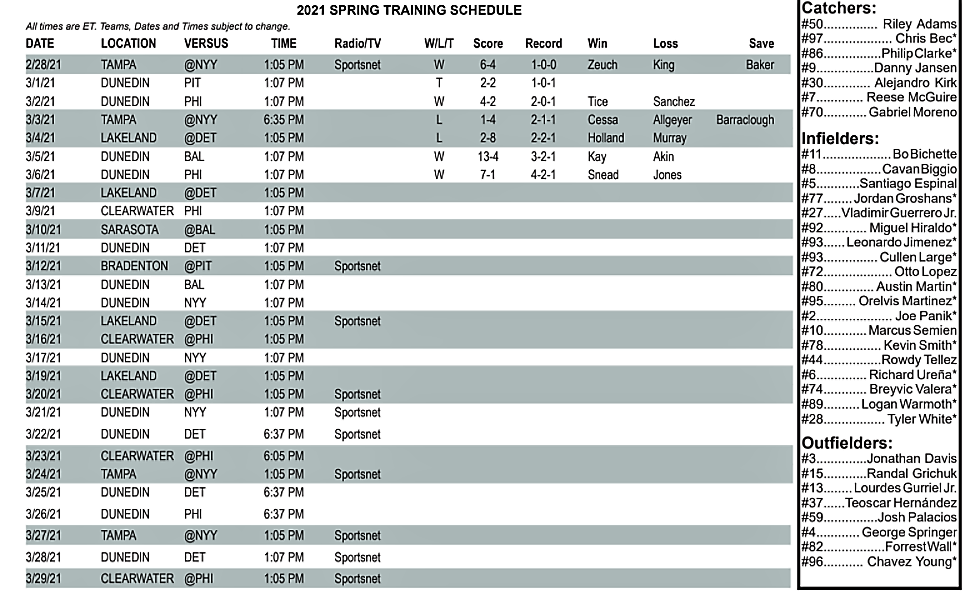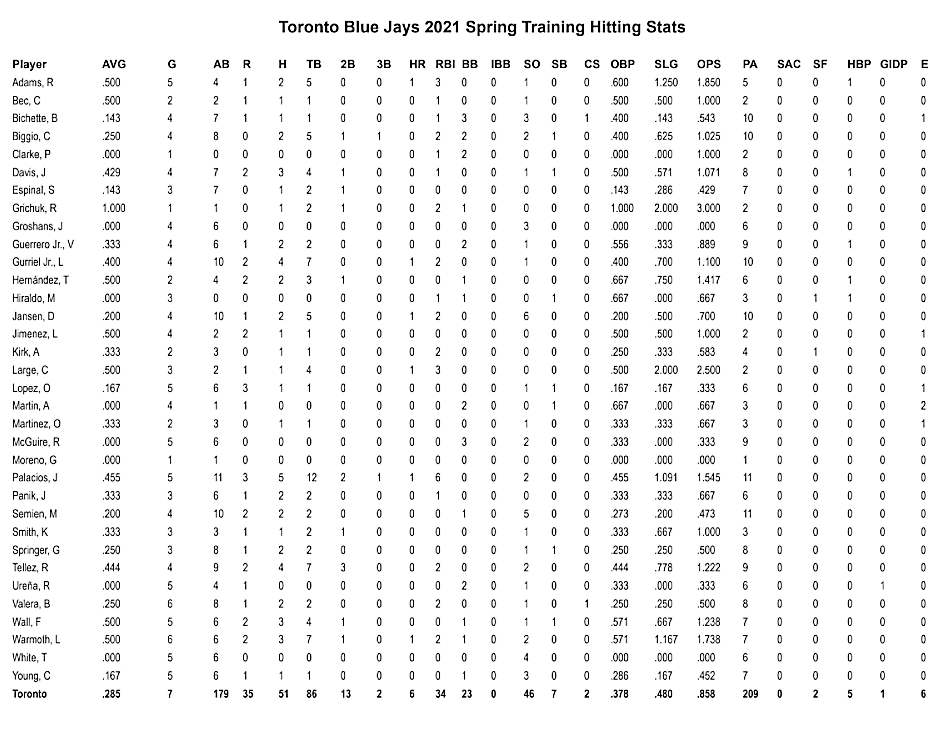
Jorge Alfaro capped San Diego’s three-run 10th inning with a two-run single, and the Padres beat the Detroit Tigers 6-4.
Jorge Alfaro gets key 10th-inning hit as Padres beat Tigers 6-4 — MLB | NBC Sports

Jorge Alfaro capped San Diego’s three-run 10th inning with a two-run single, and the Padres beat the Detroit Tigers 6-4.
Jorge Alfaro gets key 10th-inning hit as Padres beat Tigers 6-4 — MLB | NBC Sports

OAKLAND – Frankie Montas’ velocity was close to normal Thursday when he began his start in the second game of the A’s doubleheader with the Detroit Tigers. Montas’ first two four-seam fastballs were 96 and 97 mph, respectively. His first sinker was at 98 mph. Montas’ velocity dropped by the end of the third inning,…
A’s right-hander has brief outing in return from injury as Oakland beats Detroit Tigers — Chico Enterprise-Record

Carlos Rodón took a no-hitter into the seventh inning, and the Chicago White Sox completed a three-game sweep of the Detroit Tigers on Sunday.
Rodón Takes No-Hitter Into 7th; White Sox Sweep Tigers — CBS Chicago












Sign In A.J. Hinch is making his return to Major League Baseball. The former Astros manager was suspended for the 2020 abbreviated season following his involvement in Houston’s sign-stealing scandal during the team’s 2017 title run. But the Detriot Tigers on Friday announced that Hinch will be their new manager next season. As part of…
Tigers Announce A.J. Hinch As Next Next Manager With Suspension Over — NESN.com


Tigers GM Al Avila says that Detroit is not ruling out the possibility of hiring A.J. Hinch or Alex Cora for its manager vacancy.
Avila says Tigers aren’t ruling out Hinch, Cora for manager — MLB | NBC Sports
Associated PressOct 2, 2020, 7:15 PM EDTLeave a comment
DETROIT — Tigers general manager Al Avila said Friday that Detroit is not ruling out the possibility of hiring A.J. Hinch or Alex Cora for its manager vacancy.
Hinch and Cora were suspended through the 2020 postseason for their roles in the Houston Astros’ sign-stealing scandal. The Astros fired Hinch and general manager Jeff Luhnow on Jan. 13 and Cora lost his job managing the Boston Red Sox the following day.. Cora spent the 2017 season as bench coach on Hinch’s staff with Houston.
The Tigers are in the market for a replacement for manager Ron Gardenhire, who retired on Sept. 19 with a little more than a week left in the season. Avila was asked about Hinch and Cora, and while Detroit’s search appears to be in a very early stage, the GM at least seemed open to the possibility of hiring one of the suspended managers.
“Really, I can’t say that I’ve eliminated anybody,” Avila said. “The cheating scandal is not a good thing, obviously. They’re serving their suspensions, and once their suspensions are over, then they’ll be free to pursue their careers. So we have not eliminated anybody from our list at this point.”
Avila said interviews will be conducted by video, but he could meet face to face once the list of candidates is down to a small number.
“We could finish this sometime in October. It might go into November,” he said. “Really, we’re not in a rush. We’re kind of taking our time with it.”
The Tigers went 23-35 in the shortened season, finishing in the AL Central cellar for the third time in four years. They did bring up two of their most highly touted pitching prospects in Casey Mize and Tarik Skubal, so that duo got some experience in the big leagues.
Avila said it is important that the next manager be able to help with talent evaluation, since there are important decisions to make throughout the roster. He sounds open to a variety of experience levels for managerial candidates.
“I guess one thing you could eliminate is a guy that maybe played and has absolutely no coaching experience, no managerial experience, and goes from being a player directly to a major league manager,” he said. “I probably wouldn’t go that way, but everything else I would say is in play.”
Tags: A.J. Hinch, Al Avila, Alex Cora, Astros, Boston Red Sox, Detroit Tigers, Houston Astros, Jeff Luhnow, Major League Baseball, MLB, Red Sox, Ron Gardenhire, Tiger, Casey Mize, Tarik SkubalLeave a comment

Tigers reliever Tyler Alexander tied the AL record for consecutive strikeouts by fanning the first nine Reds he faced on Sunday afternoon.
Tyler Alexander records nine consecutive strikeouts, ties AL record — HardballTalk | NBC Sports

On Thursday, free agent pitcher Tyson Ross became the fifth player to opt out of the 2020 season during the novel coronavirus pandemic.
Tyson Ross opts out of 2020 season — HardballTalk | NBC Sports
On Monday, Nationals pitcher Joe Ross became one of four players to opt out of the 2020 season due to the novel coronavirus pandemic. On Thursday, Joe’s brother Tyson Ross opted out of the 2020 season as well, per Jon Heyman.
Ross, 33, is currently a free agent. He racked up 35 1/3 disappointing innings for the Tigers last year, posting a 6.11 ERA with 25 strikeouts and 18 walks.
Mike Leake, Ryan Zimmerman, and Ian Desmond are the three other players to have opted out of the 2020 season thus far. None of these players are considered “high risk,” so they are forgoing their salaries and service time.

The 2020 Major League Baseball Draft is in the books, and there’s far less to sort through this year, as the event consisted of just five rounds — instead of the usual 40 — in response to the coronavirus pandemic. There were 160 players selected Wednesday as part of the two-night draft, which was held…
2020 MLB Draft: Winners, Losers Of Baseball’s Unique, Five-Round Event — NESN.com
The 2020 Major League Baseball Draft is in the books, and there’s far less to sort through this year, as the event consisted of just five rounds — instead of the usual 40 — in response to the coronavirus pandemic. There were 160 players selected Wednesday and Thursday as part of the two-night draft, which was held remotely and seemed even more bizarre given the uncertainty hanging over the 2020 MLB season. So, which teams made the most of the condensed format and which teams whiffed with their picks? Let’s break down the winners and losers, acknowledging full well it’s nearly impossible to place teams into two such buckets in the immediate aftermath of an MLB draft since it often takes years for the players chosen (and signed) to make an impact at the major league level.
WINNERS
Detroit Tigers The Tigers owned the No. 1 pick and they didn’t screw it up. While one could argue Austin Martin is a better all-around player than Spencer Torkelson, selected first overall out of Arizona State, the Tigers added a prodigious power-hitting prospect who could mash from the middle of their order sooner rather than later. If that’s not enough, Detroit used its second-round pick on Ohio State catcher Dillon Dingler, who many were stunned to see go undrafted on Day 1, and its Competitive Balance Round B pick on LSU outfielder Daniel Cabrera, another college prospect who fills an organizational need for near-MLB-ready bats.
Kansas City Royals Don’t be surprised if we look back several years down the road and wonder how three players were selected ahead of Texas A&M left-hander Asa Lacy, whom the Royals picked at No. 4 overall. This year’s draft was loaded with college pitchers, and Lacy arguably is the best of the bunch. He’s a hard-throwing southpaw with the type of stuff scouts dream about, so there’s definitely ace upside there. Kansas City supplemented the Lacy selection with strong picks in subsequent rounds, highlighted by Nick Loftin at No. 32 overall. Loftin, a Baylor product, might be the best shortstop in the draft, although he also has the versatility to play other positions.
Toronto Blue Jays Martin was in the discussion to go No. 1 overall, and he seemed like a lock to go No. 2 once the Tigers picked Torkelson. Instead, the Baltimore Orioles threw everyone for a loop by selecting Arkansas outfielder Heston Kjerstad, paving the way for Martin to fall to No. 5, where the Blue Jays nabbed perhaps the best all-around player in the draft. Toronto already has an impressive young core. It’ll soon become even stronger. MLB Draft Results: Here’s Every Pick Of Five-Round 2020 Draft
LOSERS
Baltimore Orioles The Orioles owned the No. 2 pick and, unlike the Tigers, they did screw it up. Or so it seems. While Kjerstad could develop into a nice player, the flaws in his game — namely his strikeout tendencies — make it difficult to justify the selection, especially since Baltimore didn’t really take advantage of the money it presumably saved by drafting him over Martin. If you own the No. 2 pick, you better come away with an elite prospect. The O’s didn’t.
San Francisco Giants The Giants selected catcher Joey Bart with the No. 2 pick in the 2018 draft. Now, two years later, they went back to the same well, choosing North Carolina State backstop Patrick Bailey. This obviously gives San Francisco enviable depth behind the plate, but Bailey’s offensive upside is limited relative to other prospects available. The Giants, who owned seven picks, including five among the top 85, should’ve aimed a bit higher
. Texas Rangers The Boston Red Sox raised some eyebrows on Day 1 by selecting Nick Yorke at No. 17. But what about the Rangers following up their selection of Justin Foscue at No. 14 — a reach in itself — by choosing Evan Carter at No. 50. Carter wasn’t ranked among MLB Pipeline’s top 200 prospects. In fact, he wasn’t ranked among Baseball America’s top 500 prospects. Texas hasn’t drafted well in recent years, and it appears that trend has continued.
Read more at: https://nesn.com/2020/06/2020-mlb-draft-winners-losers-of-baseballs-unique-five-round-event/

You will never guess, in 100 tries, what their name was before it was “Tigers.”
Today in Baseball History: The Detroit Tigers become the “Tigers” — HardballTalk | NBC Sports
For starters, let’s note that the franchise that would become the Tigers was not the first major league team in Detroit. That distinction belongs to the Detroit Wolverines, who were a new member of the National League in 1881. They lasted eight seasons — winning the National League pennant in 1887 — but folded during one of the NL’s early rounds of contraction after the following season. Mostly because the owner spent too much money buying up stars he couldn’t afford. It happens.
The Tigers, like a number of the teams which would become charter members of the American League, began as a minor league club in the upstart Western League. There had been earlier iterations of the Western League before that, but this one — formed by Ban Johnson and Charles Comiskey in the winter of 1893-94 — began play in 1894. In fact, the Tigers are the only original Johnson/Comiskey Western League team that still plays where they were founded that year.
The others:
Got that? If not, try to keep up. Thanks.
Anyway, the Detroit team was not the Tigers in 1894. They were sometimes called the Wolverines, as a throwback to the defunct NL team but they were more commonly known in their first season as . . . the Creams. Unlike a lot of early teams, however, this name was not a function of the colors they wore. Rather, they were called this because team owner George Vanderbeck boasted the team would be the “cream of the league.” In this I like to think of them as nominal cousins of the Brooklyn Superbas. And it makes me wonder if there were ever teams called the “Spiffys” or the “Swells.” If not, there probably should’ve been.
The Creams would really only last a season, however, because on this date in 1895, after their victory over a local semipro team known as the Athletics, Detroit Free Press editor Philip Reid wrote the headline “Strouthers’ Tigers showed up very nicely.” Strouthers, by the way, was the team’s manager, Cornelius “Con” Strouthers, who in 1905, as manager of the Augusta Tourists of the Sally League, would sign a young player by the name of Ty Cobb and subsequently sell his contract to the Detroit Tigers for $750. That happened the same month Cobb’s mother murdered his father (she was acquitted) but that’s a whole ‘nother story. Maybe we’ll cover it in August if we still don’t have any real baseball.
Anyway.
Where did Reid come up with the name “Tigers?” On one level it was probably just a nod to their ferocious play. “Go get ’em, Tiger,” and all of that. But there was a somewhat deeper connection at play here, as “Tigers” was also the nickname for the Detroit Light Guard, a unit of Michigan’s Army National Guard, which had fought in the Civil War and would soon fight in the Spanish-American War and which still exists today as the United States Army’s 1225th Corps Support Battalion. There would’ve been a lot of local pride surrounding that unit at the time, and most historians believe that Reid was invoking them in his usage. The team would formally ask the Light Guard for official permission to use “Tigers” around 1900, when the Western League changed its name to the American League, though they had been using it informally for five years by then.
Later in 1895 Vanderbeck decided to build the team their own park, called Bennett Park, at the corner of Michigan and Trumbull Avenues in downtown Detroit. The Tigers would play their first game there on April 28, 1896, defeating the Columbus Senators. Bennett Park was built on the cheap, with the smallest seating capacity in the Western League when it became the American League. It also was kind of dangerous, as they simply laid the dirt and sod over preexisting cobblestones, which would sometimes protrude out over the dirt. Talk about a hard slide. In 1911 the Tigers would make a move to get better digs when they purchased some land adjacent to Bennett Park, demolished the stands, turned the field 90 degrees and constructed Navin Field for the 1912 season.
Like the team, it too would change named, later becoming Briggs Stadium and then, finally, Tiger Stadium, which the baseball club formerly known as the Creams would play through the 1999 season. It was a pretty good place.
Also today in baseball history:
1929: Indians’ rookie center fielder Earl Averill homers off of Tigers pitcher Earl Whitehill, becoming the first American League player to hit a home run in his first major league at-bat;
1929: In that same game, the Indians become the first team to wear numbers on the back of their jerseys on a permanent basis. The Yankees would also adopt numbers permanently in 1929, but their April 16th game was rained out, so they wouldn’t take the field in them until the following day;
1935: Babe Ruth makes his National league debut, playing for the Boston Braves and hitting a homer and a single off Giants’ legend Carl Hubbell;
1940: Bob Feller tosses an Opening Day no-hitter, beating Chicago at Comiskey Park, 1-0;
1946: Harry Truman becomes the first President to throw the ceremonial first pitch left-handed;
1948: WGN-TV in Chicago televises a baseball game for the first time. It’s an exhibition game, with the White Sox beating the Cubs 4-1. Jack Brickhouse does the play-by-play;
1983: Padres first baseman Steve Garvey, playing against his old team, the Dodgers, for the first time, appears in his 1,118th straight game, breaking the National League record for consecutive games played, previously held by Billy Williams of the Cubs. Garvey’s consecutive game streak will end at 1,207 due to a dislocated thumb. On this same date, five years later, the Padres will retire Garvey’s number;
1988: The Braves establish a National League record for losses at the start of a season by losing their tenth consecutive game. With a 7-4 defeat to the Dodgers. This streak marks the beginning of my favorite season as a baseball fan.

JOHNSON CITY, Tenn. (WJHL) – Daniel Norris is coming off career highs in games started and strikeouts, but as the Science Hill alum gears up for another season in the Motor City, Norris hosted his annual pitching clinic Saturday at RBI Tri-Cities in Johnson City. The Detroit Tigers hurler avoided arbitration on Friday and agreed […]
Daniel Norris Holds Tri-Cities RBI Pitching Clinic — WJHL | Tri-Cities News & Weather